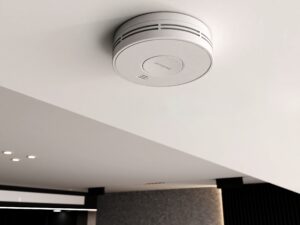Brief Summary:
A contemporary home security system that detects smoke and simultaneously sets off all of the alarms in a network is an interconnected smoke alarm. Compared to standalone units, this is a major improvement because a single trigger notifies the entire house, giving everyone vital extra time to flee. Since RF smoke alarms use radio frequency signals to communicate and are simple to install without complicated wiring, they are the most widely used kind of smoke alarm interconnect for existing homes. With the help of this technology, everyone will be immediately alerted if a fire breaks out in a garage or basement.
What is an Interconnected Smoke Alarm?
An interconnected smoke alarm system is a network of smoke detectors linked together, either by physical wiring or a wireless signal. The core principle is simple but life-saving: when any single alarm in the network detects smoke, all other alarms in the house are activated simultaneously. They all sound off in a synchronized, unmistakable alert, no matter where the initial threat was detected.
This is a fundamental shift away from traditional, “standalone” smoke alarms. An independent alarm only sounds when it detects smoke in its immediate area. Even though it’s better than nothing, this still leaves a lot of holes in your home’s security system, particularly if it has multiple stories or doors that are closed and can block sound. A garage fire can set off an alarm in the master bedroom thanks to an interconnected smoke alarm system, giving everyone immediate notice and the most time possible to evacuate safely. For this reason, the National Fire Protection Association (NFPA) advocates for interconnected systems, stating that a synchronized alarm can reduce response time and greatly improve survival rates.
The smoke alarm interconnect is the technology that makes this synchronization possible. It’s the central nervous system of your home’s fire safety, turning a collection of individual detectors into a unified, intelligent warning system.
Wired vs. Wireless: The Two Types of Smoke Alarm Interconnect
There are two primary ways to create a smoke alarm interconnect, each with its own advantages and ideal use cases. Understanding the difference is key to choosing the right system for your home.
Wired Interconnected Smoke Alarms
Wired interconnected smoke alarms are physically linked by low-voltage wiring, which is typically installed within the walls of a home during construction or a major renovation.
How they work: The alarms are hardwired to your home’s electrical system, with a physical wire connecting them all in a series. This hardwired connection carries both power and the interconnect signal.
Pros:
- Highly Reliable: The physical wiring provides a very stable and reliable connection. There’s virtually no risk of signal interference.
- Continuous Power: Since they are hardwired, you don’t need to worry about replacing batteries to power the main unit. They all have a battery backup to ensure they still work during a power outage.
Cons:
- Difficult Installation: The biggest drawback is the cost and complexity of installation in an existing home. Running new wires through finished walls and ceilings is a messy and expensive job that usually requires a licensed electrician.
- Lack of Flexibility: Once the wires are in place, it’s difficult to add or move an alarm, limiting the system’s scalability.
Wired systems are the traditional gold standard for new construction because they are integrated seamlessly into the home’s infrastructure from the start.
Wireless (RF) Interconnected Smoke Alarms
Wireless interconnected smoke alarms use radio frequency (RF) signals to communicate with each other. They are often called RF smoke alarms or RF smoke detectors and have become the go-to solution for retrofitting existing homes.

How they work: Instead of a wire, each alarm has a built-in radio transmitter and receiver. When one alarm detects smoke, it broadcasts a unique RF signal to all other alarms in the network, triggering them to sound.
Pros:
- Easy DIY Installation: Because there is no wiring, these systems are incredibly easy to install. You simply mount each alarm in its location, and they “learn” each other with a quick pairing process.
- Versatile & Scalable: You can easily add more alarms to the network or change their locations as needed, making the system highly flexible for any home layout.
- Modern Features: Many RF smoke alarms come with smart home capabilities, such as mobile app alerts, battery status updates, and remote silencing.
Cons:
- Battery Dependency: The RF communication is powered by batteries, which must be replaced periodically (though many modern models use a sealed 10-year battery for the unit’s entire lifespan).
- Potential for Interference: While modern systems are designed to be robust, there is a small potential for signal interference from other wireless devices.
- For most homeowners looking to upgrade their safety system without a major renovation, RF smoke alarms are the most practical and cost-effective solution. They provide the same life-saving functionality as wired systems, with the added benefit of easy installation and advanced features.
Key Features to Look for in Your Interconnected System
When shopping for interconnected smoke alarms, consider these essential features to build a robust and reliable safety net.
1. Power Source & Battery Backup
10-Year Sealed Battery: Many modern RF smoke alarms come with a non-replaceable, 10-year battery. This is the most convenient option, as it eliminates the need to remember to change batteries every six months and guarantees power for the device’s entire lifespan.
Hardwired with Battery Backup: Wired systems are hardwired to the home’s power but always include a battery backup to ensure the system remains functional during a power outage.
2. Sensor Technology
Modern interconnected smoke alarms can use one of three sensor types:
Ionization: Best for detecting fast-flaming fires (e.g., grease fires).
Photoelectric: Best for detecting slow, smoldering fires (e.g., electrical fires).
Dual-Sensor: The gold standard, combining both ionization and photoelectric sensors to detect both types of fires. For the most complete protection, choose a system with dual-sensor technology.
3. Smart Features & Integration
Modern interconnected smoke alarms often integrate with your smart home. Look for features like:
Mobile Alerts: Receive notifications on your smartphone if an alarm is triggered, no matter where you are.
Voice Alerts: Instead of just a beep, the alarm can announce the type of emergency (“Fire!”) and its location (“Basement!”).
Remote Silencing: Silence nuisance alarms (e.g., from cooking smoke) from your phone without having to reach the alarm itself.
4. Combination Smoke and CO Alarms
For a truly comprehensive solution, consider a combination smoke alarm interconnect system that also includes carbon monoxide detection. These combo units save on installation costs and time while providing a complete safety net against both fire and CO poisoning.

Proper Placement & Maintenance of Your System
Even the best interconnected smoke alarms are only as good as their placement and maintenance. Follow these guidelines to ensure your system is always ready to protect you.
Placement
The NFPA recommends a smoke alarm interconnect system be installed in these key locations:
- On every level of your home, including the basement.
- Inside every bedroom.
- In the hallway outside of sleeping areas.
- At least 10 feet away from cooking appliances to avoid nuisance alarms.
For wired systems, ensure the wiring is properly installed by a professional. For RF smoke alarms, simply mount them according to the manufacturer’s instructions.
Maintenance
Test Monthly: Use the test button on each alarm to ensure it is functioning properly. For an interconnected system, pressing the test button on one alarm should trigger all others in the network.
Clean Annually: Vacuum or wipe the outside of each alarm to remove dust and debris that could interfere with the sensor.
Replace on Time: Replace all interconnected smoke alarms every 10 years (or as recommended by the manufacturer), as their sensors degrade over time.
Conclusion
A fire can engulf a home in minutes, but the most dangerous threat is not the flames—it’s the smoke. The extra seconds or minutes of warning provided by an interconnected smoke alarm can be the difference between a successful escape and a tragic outcome.
By upgrading your home’s safety system, whether with a wired installation or a modern, easy-to-install network of RF smoke alarms, you are making a crucial investment in the lives of everyone under your roof. The synchronized signal of a smoke alarm interconnect is more than just a loud noise; it’s the sound of a unified, immediate alert that gives your family the precious time they need to get out safely. Don’t wait until it’s too late—protect your home with a whole-home safety system today.
Reference:


